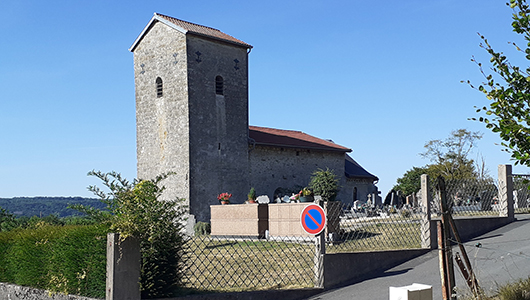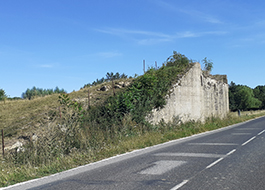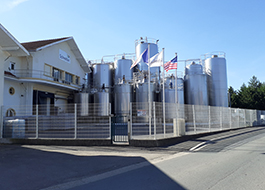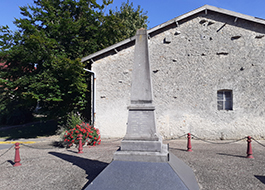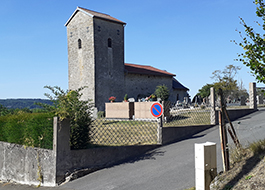Cléry-le-Petit
Durée visite : 40 minutes
Moyen : Pédestre
Le village dépendait autrefois de Cléry-Grand. De la forteresse médiévale ne subsiste qu’une tour carrée, employée comme clocher par l’église. Depuis 1922, Cléry-le-Petit possède une fromagerie, qui est la plus importante unité industrielle du canton. En août 1914, la 9ème Division d’infanterie tente ici, et en vain, d’arrêter la progression allemande.
The village once depended on Cléry-Grand. All that remains of the medieval fortress is a square tower used as a bell tower by the church. Since 1922, Cléry-le-Petit has had a cheese dairy, which is the largest industrial unit in the canton. In August 1914, the 9th Infantry Division tried here and in vain to stop the German advance.
Das Dorf war einst von Cléry-Grand abhängig. Von der mittelalterlichen Festung ist nur noch ein viereckiger Turm übrig geblieben, der von der Kirche als Glockenturm genutzt wurde. Cléry-le-Petit besitzt seit 1922 eine Käserei, die grösste Industrieeinheit des Kantons. Im August 1914 versuchte hier die 9. Infanteriedivision vergeblich, den deutschen Vormarsch aufzuhalten.

De gueules à la grappe de raisin d’or; mantelé renversé, crénelé et cousu d’azur, chargé d’une cruche à lait d’argent, accompagnée aux flancs de deux étoiles du même.
Gules to the bunch of golden grapes; Mantle reversed, crenellated and stitched azure, charged with a jug with silver milk, accompanied on the flanks of two stars of the same.
Gules zu der Traube goldener Trauben; Mantel umgekehrt, zinnen und azurblau genäht, aufgeladen mit einem Krug mit silberner Milch, begleitet an den Flanken von zwei Sternen desselben.
Les points de visites
.
Les importantes et très longues buttes de terre, qui masquent l’entrée de l’agglomération en venant de Doulcon, sont des vestiges de l’infrastructure de la ligne de chemin de fer, dite stratégique parce qu’elle devait alimenter la ligne Maginot. Le dispositif permet ici à une locomotive de changer de sens en manœuvrant. Cela date de 1930.
The large and very long mounds of earth, which hide the entrance to the town from Doulcon, are vestiges of the infrastructure of the railway line, said to be strategic because it must supply the Maginot line. The device here allows a locomotive to change direction while shunting. It dates from 1930.
Die großen und sehr langen Erdhügel, die den Eingang der Stadt von Doulcon aus verdecken, sind Überreste der Infrastruktur der Eisenbahnlinie, die als strategisch wichtig gilt, weil sie die Maginot-Linie versorgen muss. Das Gerät hier ermöglicht es einer Lokomotive, während des Rangierens die Richtung zu ändern. Es stammt aus dem Jahr 1930.
.
.
Créée en 1922 à partir des bâtiments d’un ancien moulin, la fromagerie de Cléry-Petit a appartenu à cinq sociétés différentes. Son activité n’a cessé de progresser, comme le montre l’importance de ses installations. La fabrication des premières années portait, en plus du beurre, sur des fromages à pâte molle; le Brie de Cléry-le-Petit était d’excellente qualité. Grâce à la fromagerie, Cléry-le-Petit est un des rares villages qui ait aujourd’hui le même chiffre de population qu’en 1850, date du chiffre le plus élevé de la population rurale. Les 283 membres de ce personnel ne vivent pas tous sur place; Cléry-le-Petit au dernier recensement compte 184 habitants. C’est dire le bienfait pour la région d’une entreprise, qui reçoit le « fleuve blanc » de 1100 producteurs nord-meusiens.
Created in 1922 from the buildings of an old mill, the Cléry-Petit cheese dairy belonged to five different companies. Its activity has continued to progress, as shown by the importance of its facilities. The manufacture of the first years related, in addition to butter, to soft cheeses; the Brie from Cléry-le-Petit was of excellent quality. Thanks to the cheese dairy, Cléry-le-Petit is one of the rare villages which today has the same population figure as in 1850, the date of the highest figure for the rural population. The 283 members of this staff do not all live on site; Cléry-le-Petit at the last census has 184 inhabitants. This is to say the benefit for the region of a company, which receives the « white river » of 1100 North Meuse producers.
Die Käserei Cléry-Petit wurde 1922 aus den Gebäuden einer alten Mühle gegründet und gehörte fünf verschiedenen Unternehmen. Seine Tätigkeit hat sich kontinuierlich weiterentwickelt, wie die Bedeutung seiner Einrichtungen zeigt. Die Herstellung der ersten Jahre bezog sich neben Butter auf Weichkäse; der Brie aus Cléry-le-Petit war von ausgezeichneter Qualität. Dank der Käserei ist Cléry-le-Petit eines der seltenen Dörfer, das heute die gleiche Bevölkerungszahl hat wie 1850, dem Datum der höchsten Bevölkerungszahl auf dem Land. Die 283 Mitglieder dieses Personals wohnen nicht alle vor Ort; Cléry-le-Petit hat bei der letzten Volkszählung 184 Einwohner. Dies ist der Vorteil für die Region eines Unternehmens, das den „weißen Fluss“ von 1100 Erzeugern der Nordmaas erhält.
.
C’est un obélisque très sobre. Le marsouin Paul Chollet est né à Cléry-Petit en 1895. Il est mort en octobre 1916 à Vakufkoï, en Grèce. Il appartenait au 56e Régiment d’Infanterie Coloniale. Créée en août 1915, cette unité est intégrée à la 1ère Division d’Infanterie, du Corps expéditionnaire des Dardanelles, en octobre de la même année. Après l’échec de Gallipoli, les troupes embarquent pour Salonique, le 10 février 1916. Ils mènent divers opérations contre les Turcs et les Bulgares. L’infanterie coloniale est formée de métropolitains. A ne pas confondre avec les tirailleurs indigènes ou l’Armée d’Afrique.
It is a very sober obelisk. The porpoise Paul Chollet was born in Cléry-Petit in 1895. He died in October 1916 in Vakufkoï, Greece. He belonged to the 56th Colonial Infantry Regiment. Created in August 1915, this unit was integrated into the 1st Infantry Division of the Dardanelles Expeditionary Corps, in October of the same year. After the failure of Gallipoli, the troops embarked for Salonica on February 10, 1916. They carried out various operations against the Turks and the Bulgarians. The colonial infantry is made up of metropolitans. Not to be confused with the indigenous skirmishers or the Army of Africa.
Es ist ein sehr nüchterner Obelisk. Der Schweinswal Paul Chollet wurde 1895 in Cléry-Petit geboren. Er starb im Oktober 1916 in Vakufkoï, Griechenland. Er gehörte dem 56. Colonial Infantry Regiment an. Diese im August 1915 gegründete Einheit wurde im Oktober desselben Jahres in die 1. Infanteriedivision des Dardanellen-Expeditionskorps integriert. Nach dem Scheitern von Gallipoli schifften sich die Truppen am 10. Februar 1916 nach Saloniki ein. Sie führten verschiedene Operationen gegen die Türken und die Bulgaren durch. Die koloniale Infanterie besteht aus Metropoliten. Nicht zu verwechseln mit den indigenen Scharmützlern oder der Armee von Afrika.
.
Datée du XIIe siècle pour ses parties les plus anciennes, Saint-Vincent est pourvue d’un vaisseau unique et d’une tour carrée. Celle-ci a servi de refuge pendant les guerres du XVIe et XVIIe siècles. L’église est ornée de vitraux modernes de l’atelier Gross, de Nancy, réalisés en 1954. Une statue du XVe représente saint Vincent de Saragosse, martyrisé sous Dioclétien vers 304, patron des vignerons, avec son attribut : la grappe de raisin. Ce rôle serait dû à un jeu de mot sur son nom : Vin-sang.
Dating back to the 12th century for its oldest parts, Saint-Vincent has a single nave and a square tower. This served as a refuge during the wars of the 16th and 17th centuries. The church is decorated with modern stained glass windows from the Gross workshop, from Nancy, made in 1954. A 15th century statue represents Saint Vincent of Zaragoza, martyred under Diocletian around 304, patron saint of winegrowers, with his attribute: the bunch of grapes.
Saint-Vincent geht in seinen ältesten Teilen auf das 12. Jahrhundert zurück und hat ein einziges Kirchenschiff und einen quadratischen Turm. Diese diente während der Kriege des 16. und 17. Jahrhunderts als Zufluchtsort. Die Kirche ist mit modernen Buntglasfenstern aus dem Jahr 1954 der Werkstatt Gross aus Nancy geschmückt. Eine Statue aus dem 15. Jahrhundert stellt den Heiligen Vinzenz von Saragossa dar, der um 304 unter Diokletian den Märtyrertod erlitt, dem Schutzpatron der Winzer, mit seinem Attribut: der Weintraube.

